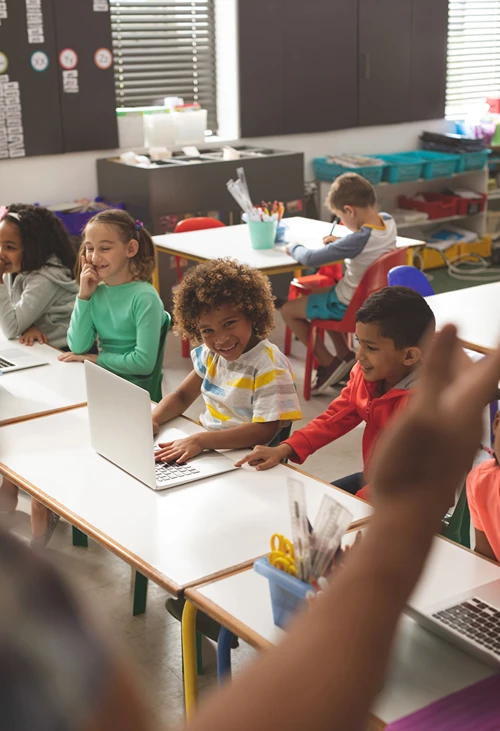Parent Tips: Rewarding Responsible Online Behavior
Today’s kids have the world at their fingertips. From how they learn in school to how they communicate with their peers and spend their leisure time; everything centers around screens and the Internet. Being online is no longer just a hobby or a luxury for children. It’s a necessity, which means kids are spending more time than ever online, scrolling for hours each day.
But behind the instant information, sharable memes, and viral social trends lurk dangers today’s parents never had to worry about when they were kids. Gone are the days of only having to worry about children talking to strangers or looking both ways before they cross the street. And with emerging technology like AI, protecting children from the Internet has become even more complicated and troubling for parents.
RISKS AT EVERY TURN
Whether it’s cyberbullying, online predators, AI-generated misinformation, unrealistic portrayals of life, or constant cyberattacks like phishing and ransomware, children are exposed to a number of risks every minute they’re online. What may seem like harmless scrolling can actually be extremely harmful to their mental development and self-esteem. In fact, studies show that social media has led to a rapid increase in mental health issues among children and teens. And to make matters worse, social media is strategically designed to be addictive, causing spikes in dopamine and even causes withdrawal symptoms when not used for prolonged periods.
That’s why it’s imperative for parents to teach their kids responsible online behavior, and reward their good choices to encourage future ones. From protecting their personal information to limiting their social media use to thinking critically about what they see and share online, responsible online behavior can keep your children safer, healthier, and happier. It also helps them to focus their energies on the Internet’s positives, such as learning, connection, and creativity.
RESPONSIBLE HABITS THAT SHOULD BE REWARDED
Reinforcing good habits is the surest way to protect your kids from the dangers of online use. Whether it’s learning to avoid inappropriate content or being kinder to others on social media, rewarding responsible behavior will help ensure they continue to make smart choices.
PROTECTING PERSONAL INFORMATION
Scammers are getting smarter and use clever tricks to get unsuspecting online users to willingly give out their personal information—and kids can be the most vulnerable to their tactics. Teaching your kids to always think first and distrust strangers online will help them protect their personal information.
- Not sharing details like their full name, address, phone number, or school.
- Using strong passwords that require two-step identification.
- Avoiding links and PDFs sent from unknown sources.

THINKING BEFORE POSTING
Kids often forget that what they post can live permanently online, even if they delete it. Teaching them to create a positive digital footprint will help them avoid regretful posts that can hurt others or themselves.
- Getting parental permission before posting online.
- Being respectful and kind when commenting on others’ posts.
- Reporting cyberbullying to a teacher or parent.
LIMITING SCREEN TIME
The more time kids spend online, the more it can negatively affect all aspects of their life. Mental health, school performance, social skills, and even sleep can all be harmed by too much screen time.
- Respecting parental-set screen time limits.
- Spending more time offline and enjoying activities such as hobbies, sports, family time, and volunteering.
REWARDING RESPONSIBLE BEHAVIOR
Now for the fun part. Effective and rewarding for both parents and kids alike, associating responsible online behavior with physical rewards is a great way to encourage future smart choices. Gifts like bespoke coins and custom medals for awards create physical reminders of a child’s good behavior, and can help to reinforce responsibility and build self-confidence.
PERSONALIZED COINS
Coins are a fun way to reward responsible behavior and get kids excited about making good choices. Kids love custom recognition coins, because they look great on display and serve as a proud reminder of their accomplishments. Whether it’s hard enamel coins or soft enamel options, it’s never been easier for parents to order customized coins online and create the ultimate reward for their kids.
📲 Create a customized coin featuring a clock and a smartphone to reward good screen time behavior.
🎶 Order a personalized coin that features their favorite offline hobby and encourage them to keep spending less time online.
🔍 Design a detective-themed coin to celebrate their skills at detecting pernicious emails and text messages.
♥️ Personalize a coin that celebrates kindness to reward your kids for being empathetic and positive on social media.
CUSTOMIZED MEDALS
Gifting medals for responsible online behavior provides a sense of achievement for kids. They can be proudly displayed or worn on backpacks and jackets, and each medal can tell a durable visual story that can last a lifetime. It’s easy to design your own award medals and personalize them to your satisfaction.

🏅 Create a recognition medal to celebrate a personal online achievement, such as posting positive messages and spending less time on social media.
🏀 Design a customized sports medal to reward your child’s athletic pursuits — the more they enjoy sports, the less time they’ll spend staring at a screen.
📚 Gift a school medal that features their initials and GPA to reward using responsible online behavior that helps them achieve good grades.
🔒 Reward your child with a medal that commemorates their strong online privacy settings.
REWARD GOOD BEHAVIOR WITH GREAT GIFTS
If you’re a parent concerned about your child’s Internet usage and the risks it brings, rewarding responsible online behavior is an effective way to teach them to be smarter and safer. Rewards like customized coins and medals provide fun, physical tokens that represent a moment in time your child can draw inspiration from as they make future choices online.
To buy custom medals and coins and reward good behavior, visit the pros at THE/STUDIO. With first-class customization options, you can make your own coin designs to your exact specifications and create gifts your kids will cherish for years to come. Order today and help create healthier, safer online habits.








